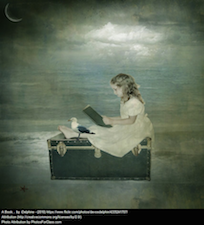4.9 Special Effects and Patterns for Poems
| Site: | Cowichan Valley School District - Moodle |
| Course: | ELA5, CSS, Sferrazza |
| Book: | 4.9 Special Effects and Patterns for Poems |
| Printed by: | Guest user |
| Date: | Friday, 19 December 2025, 12:23 AM |
Learning Targets
By the end of this lesson, you should be able to say YES to the following questions.
- Can I recognize how literary devices enhance meaning?

Special Effects
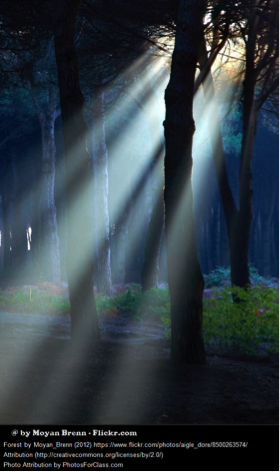 “hot metal language”
“hot metal language”
“planes overhead roar an orchestra of rolling drums”
“lips were as red as a wailing firetruck"
“the road was a ribbon of moonlight”
“the clutter clustered clingingly”
Literary devices are the tools writers use to create special effects in their writing.
They are the sunbeams through the forest that make readers go, “Oooooh! Aaaaaah!”
Do you like crafts or building with Lego? Have you ever used a pattern? A pattern usually shows you the steps you need to follow.
Today, you will write a free verse poem using a special five-line pattern and our three special effects:
- similes
- metaphors
- alliteration
You can be a "special effects" writer when you use literary devices, just like the sunbeams add a special effect to the image on this page.
Alliteration
Can you recall the definition of alliteration by looking at the underlined hints in the stanza below?
There is no clutter cluttered up
more closely, I presume,
than the clutter clustered clingingly
in my friend, Betty's room.
(from the poem "Betty's Room" in A Little Bit of Nonsense by Denise Rodgers)
Watch the video to learn more about alliteration:
Alliteration Practice
Alliteration can make poetry more interesting and memorable, especially when recited out loud. It’s a fun play of words that brings out the imagination of the writer and the reader.
Do the following lines / phrases have alliteration?
Deep into that darkness peering, long I stood there wondering, fearing, doubting, dreaming dreams no mortal ever dared to dream before... (From The Raven by Edgar Allan Poe)
Marvelous mouth-watering melting moments...
A winter blanket
covers the Earth in repose
but only a dream
At history I'm hopeless.
At spelling I stink.
In music I'm useless.
From science I shrink.
(Copyright © 2007 Kenn Nesbitt - All Rights Reserved - From www.poetry4kids.com)
Simile
Why would an author want to spend time comparing two things that are different from one another?
Why use these kinds of phrases?
- Similes, and other forms of figurative language, are like sunbeams through the forest that make readers go, “Oooooh! Aaaaaah!”
- They make writing more vivid and clear.
- They help to paint a picture with words that the reader can more easily see and feel.
As you can tell by the video you just watched, comparisons can be used to present feelings, images, or ideas in a fresh, often more powerful way!
Simile Practice
Remember, a simile is a comparison using such words as "like" or "as". Here are some examples:
I’m about as awesome as a flying giraffe.
The villains looked as fierce as lions with their wild manes of hair and snarly looks.
The music burst like a pent-up flood.
Her laughter was like a warm blanket or a familiar song.
Which of the following are similes?
The clouds are like galleons in the sky.
Ben’s temper was a volcano, ready to explode.
Her lips were as red as a wailing firetruck.
Metaphor
Metaphor, like similes, make a comparison of things that are not similar. Unlike similes, the comparisons do NOT use like or as. Take a look!
Metaphor Practice
Which of the following are metaphors?
The road was a ribbon of moonlight.
The sky is a patchwork quilt.
The thunder roared like a mighty lion.
Just For Fun - Challenge
Can you find the simile or metaphor in each song?
Learning Guide
Go to your Learning Guide to practice writing your own alliterations, similes, and metaphors. Then, return to this lesson to learn how to use a specific pattern to write your own free verse poem that uses alliteration, simile, and metaphor.

Word Play Example
Before you write a pattern poem of your own that uses alliteration, similes, and metaphor, let's take a look at an example. To begin, imagine you are camping, it is the middle of the night, and you wake up in a thunderstorm.
Here is an example of prewriting for this scenario:
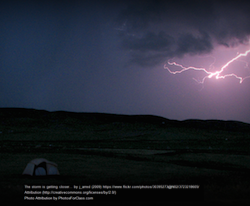
LINE ONE: Write a word or phrase to tell how you feel.
Terrified
LINE TWO: Write down a word or phrase to tell what you see.
Lightning
LINE THREE: Write down a word or phrase to tell what you hear.
Thunder, Rain, Wind
LINE FOUR: Write down a word or phrase to tell what you do.
Cover ears.
LINE FIVE: Write down a word or phrase to end the poem.
Hide in sleeping bag.
Word Play Example - Step Two
Remember, you are camping, it is the middle of the night, and you wake up in a thunderstorm. It is time to play with the words in each line and to create pictures with alliteration, similes, and metaphors.


LINE ONE: Write a word or phrase to tell how you feel.
Terrified as a mouse caught in a trap, (simile)
LINE TWO: Write down a word or phrase to tell what you see.
Streaks of brilliant lightning rip across the night sky.
LINE THREE: Write down a word or phrase to tell what you hear.
BOOM! (onomatopoeia) Thunder crashes like elephants in my room (simile) while the wind is a wolf howling at the moon (metaphor).
LINE FOUR: Write down a word or phrase to tell what you do.
I cover my ears, squeeze shut my eyes,
LINE FIVE: Write down a word or phrase to end the poem.
And dive deep down (alliteration) into my sleeping bagl
Your Turn
 Complete the steps as follows in your Learning Guide to write your own five line poem.
Complete the steps as follows in your Learning Guide to write your own five line poem.

1. Choose one of the following situations:
- You are exploring an empty old house when suddenly a door bangs shut behind you.
OR
- You are walking through a meadow when suddenly, a strange beast steps out from behind a tree.
2. Follow these steps in your Learning Guide to begin planning your poem:
LINE ONE: Write a word or phrase to tell how you feel.
LINE TWO: Write down a word or phrase to tell what you see.
LINE THREE: Write down a word or phrase to tell what you hear.
LINE FOUR: Write down a word or phrase to tell what you do.
LINE FIVE: Write down a word or phrase to end the poem.

Now, try playing with the words in each line and add to your ideas to create pictures with words. Be sure to use one alliteration, as well as at least one simile and one metaphor. Hint: Don't use these tools on every line. To make your poem interesting, try different ways to paint pictures with words on each line.
Revising
![]()
Make changes to improve your writing. While making this changes, think VOICE:
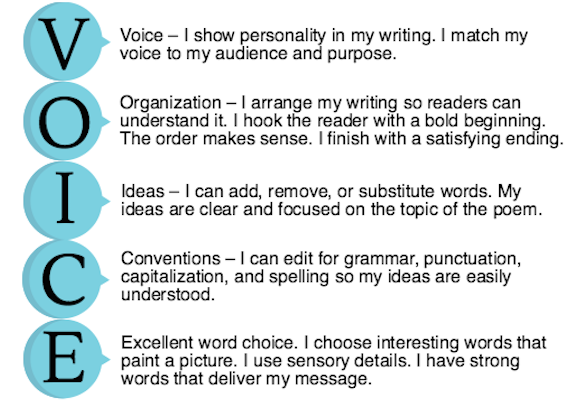
Editing

- Patrol your writing for CUPS. Make corrections as needed.
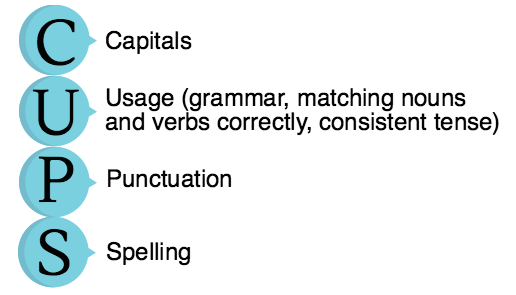
Next Steps
 The next step in the writing process is "Evaluating". In your Learning Guide, think and talk about the evaluating questions with your home facilitator. Decide how well you think your rough draft meets the criteria. Revise and edit your poem more, if you feel it is needed.
The next step in the writing process is "Evaluating". In your Learning Guide, think and talk about the evaluating questions with your home facilitator. Decide how well you think your rough draft meets the criteria. Revise and edit your poem more, if you feel it is needed.

 The last step is "Publishing". This step will be saved for project choices at the end of the poetry unit. For now, this lesson and poem are completed. Congratulations!
The last step is "Publishing". This step will be saved for project choices at the end of the poetry unit. For now, this lesson and poem are completed. Congratulations!

Do you have someone you can share your poem with now?
Reminder
When you do your independent poetry reading, look for literary devices. Then, add to your poetry reading journal to show your independent reading reflections.
